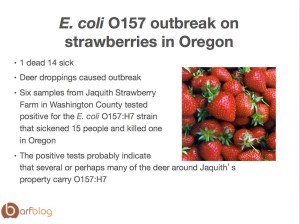Objectives Assess the disease severity of Shiga toxin-producing Escherichia coli (STEC) O157 infection and factors influencing the development of typical haemolytic uraemic syndrome (tHUS).
 Design A retrospective cohort study using data collected through routine surveillance questionnaires between 2009 and 2012.
Design A retrospective cohort study using data collected through routine surveillance questionnaires between 2009 and 2012.
Participants 3323 symptomatic cases of STEC O157.
Main outcome measures Incidence of human STEC O157 and tHUS, proportion of cases reporting bloody diarrhoea, hospitalisation, tHUS and death. Odds of progression to tHUS and predicted percentage chance of developing tHUS based on case demographics, STEC O157 strain characteristics and clinical symptoms.
Results From 2009 to 2012, 3323 cases of symptomatic STEC O157 with completed questionnaires were reported, of which 172 developed tHUS (5.18%). Being aged 1–4 years (OR 8.65, 95% CI 5.01 to 14.94, p=0.004) or female (OR 1.61, 95% CI 1.12 to 2.30, p=0.009), being infected with phage type (PT) 21/28 (OR 2.07, 95% CI 1.25 to 3.42, p=0.005) or PT 2 (OR 2.18, 95% CI 1.06 to 4.50, p=0.034), receiving β-lactam antibiotics (OR 4.08, 95% CI 1.43 to 11.68, p=0.009) and presenting with vomiting (OR 3.16, 95% CI 2.16 to 4.62, p<0.001) or bloody diarrhoea (OR 2.10, 95% CI 1.38 to 3.20, p=0.001) were found to be significant risk factors for progression to tHUS. The predicted percentage chance of developing tHUS varied from under 1% to 50% if all risk factors were present.
Conclusions The data from this study indicate the use of β-lactam antibiotics should be avoided in suspected cases of STEC infection in all age groups, particularly in those under the age of 5.
Disease severity of Shiga toxin-producing E. coli O157 and factors influencing the development of typical haemolytic uraemic syndrome: a retrospective cohort study, 2009–2012
BMJ Open 2016;6:e009933
N Launders, L Byrne, C Jenkins, K Harker, A Charlett, G K Adak
